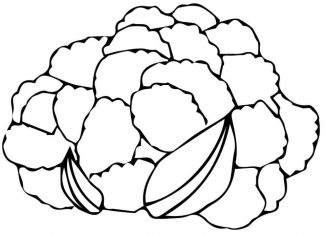Cauliflower (Brassica oleracea var. botrytis) is a vegetable of the cruciferous family (Brassicaceae), which is characterized by its dense, compact "spherical" inflorescence.
Coloring Book Cauliflower
information
- Characteristics: Cauliflower has a spherical, compact inflorescence composed of many small flowers. The inflorescence is protected by the leaves, and the flowers themselves are usually eaten at the development stage when the cauliflower is harvested.
- Color: Cauliflower comes in a variety of colors, from white to yellow, green, purple and other shades. The color is often dependent on the variety and growing conditions.
- Taste and Consistency: It has a delicate taste and texture, making it a popular ingredient in many dishes.
- Nutritional Value: Cauliflower is rich in vitamin C, vitamin K, vitamin B6, folic acid, fiber and many minerals such as potassium and magnesium.
- Culinary Uses: Cauliflower is a versatile cooking ingredient that can be boiled, steamed, baked, grilled, stewed or served raw. It can be used in salads, soups, main dishes and as a snack.
- Cauliflower Rice: In recent years, "cauliflower rice" has become a popular alternative to traditional rice, especially among people who avoid carbohydrates or are looking for lighter dietary options.
- Source of Antioxidants: Cauliflower is rich in antioxidant plant compounds, such as sulforaphane, which help protect the body from oxidative stressors.
- Cultural and Historical Contingencies: Cauliflower has a long history of cultivation and has been grown by various cultures over the centuries.
- Specialty Varieties: In addition to the classic white cauliflower, there are also colorful varieties, such as purple or green cauliflower, which contain various nutritional compounds and are eye-catching on the plate.
- Cultivation: Cauliflower is a plant that requires well-drained soil and a temperate climate. It requires regular watering and protection from pests.
trivia
- Cauliflower vs. Broccoli: Cauliflower is closely related to broccoli, both belonging to the cruciferous family. Their similarity is particularly evident in the structure of the inflorescences.
- Purple Cauliflower: There is a variety of purple-colored cauliflower known as purple cauliflower. Not only is it an interesting alternative in the kitchen, but it also contains anthocyanins, which are powerful antioxidants.
- Cauliflower "Obvious" and Other Shapes: In 2016, a variety of cauliflower known as "obvious cauliflower" appeared on the market, which has an exceptionally translucent structure. There are also cauliflower varieties with a slightly different shape, such as the "Romanesco" variety, which has characteristic pyramidal and spiral structures.
- Cauliflower in the Sphere of Meat Dishes: More and more chefs and restaurants are experimenting with cauliflower, using it as a "substitute" for meat, such as in the preparation of cauliflower "wings" or cauliflower "burgers."
- Potatoes Instead of Cauliflower: In some cases, cauliflower is used as a substitute for potatoes in the preparation of mashed potatoes. This is a lower carbohydrate option.
- A Strange Growing Story: For many centuries, cauliflower was considered a difficult vegetable to grow and was not as popular as other plants from the cruciferous family.
- The Ketogenic Diet: Because of its relatively low carbohydrate content, cauliflower is sometimes used in the ketogenic diet as a substitute for carbohydrate-rich foods.
- Growing at Height: Cauliflower is grown at high altitudes. In the Andes region of Bolivia, cauliflower varieties adapted to higher terrain are grown.
- The word "Cauliflower" in Other Languages: The name "cauliflower" has different equivalents in different languages. For example, in Spanish it's "coliflor" and in French it's "chou-fleur."
- Creative Preparation: Cauliflower can be subjected to a variety of heat treatments, such as roasting, frying, steaming and grilling, to achieve different flavors and textures.










